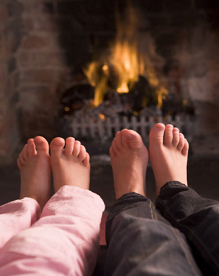Table of Contents
Winter Foot Care - Introduction
The winter can be hard on our bodies. The cold air and driving winds can leave our lips chapped and our hands raw. At least those signs are easy to see. What about our feet?
Since your feet are covered in socks and shoes all day, and you don’t see them in the mirror very often, you might not be aware of a developing issue. Then all of a sudden, you’re hit with a bit of pain, announcing that your foot has a problem you never saw coming.
If you think you may be suffering from frostbite or some kind of foot injury, make an appointment for a foot radiograph right away. Foot injuries need immediate treatment. Otherwise, you’ll risk making it worse with each step you take!
To minimize the risk of a surprise foot problem, you should take care of your feet in the winter. Check out our tips to protect your feet during cold weather.
Remove Wet Socks and Boots Immediately
If your sneakers, shoes, or boots get soaked at some point during your day, you should remove them and allow them to dry out. But don’t stop there. If your outer footwear lets any water through, your socks will be wet as well. Get them off!
The last thing your feet need is to sit in a pair of damp socks all day. That’s a recipe for letting bacteria, fungus, and even mold start to grow. Leaving your wet socks on can also quickly lead to bad smells. In frigid environments, that moisture on your socks can also draw heat out of your body through your feet and could lead to acute issues, including frostbite. So, it’s always a good idea to have an extra pair of socks to change into on the go.
Clean and Moisturize Your Feet
Your feet take all kinds of abuse in the course of the thousands of steps you take per day. Even in ideal circumstances, it’s easy for them to blister, crack, and even bleed. If you develop deep cracks called fissures, they can become a conduit allowing fungus and bacteria to enter your foot and bloodstream, potentially making you very sick.
Instead of neglecting the skin on your feet, clean it every day and routinely feed it with a quality moisturizer. If you’re smart and apply your moisturizer before there is a problem, it’s less likely an issue like cracking will ever develop. Just like when your lips are chapped, it doesn’t do much good to wait until they’re bleeding to apply some cream.
Let Them Breathe
Feet aren’t necessarily our most attractive feature. But don’t hide them away all the time. Spending a couple of hours with your feet uncovered, maybe when you’re near the fireplace and all warm and toasty, gives the skin a chance to heal.
You can also take advantage of breathable clothing to maintain and protect your feet in cold weather. Many boots and socks provide not only insulation but moisture-wicking technology. These pieces of clothing, often made with wool, allow your sweat to absorb into the fabric and then evaporate, leaving your skin dry.
That’s an advantage in cold environments, where moisture combined with frigid air can cause a rapid onset of frostbite. So, if you see signs of excessive moisture like wrinkled toes after you remove your socks at the end of the day, consider changing up your wardrobe and using more breathable fabrics on your feet.

Don’t Squeeze
When it gets cold, it’s tempting to add layers. That’s often a good idea, but not when it comes to footwear. If you try to squeeze two pairs of socks into your shoes, they could become too tight and cause circulation issues. It’s normal to see a bit of an impression of your socks around your ankle after taking them off. But if some deep lines or creases last more than a few minutes, you need to get looser-fitting socks and boots.
Final Tip: Use Caution
We have to anticipate potentially treacherous travel conditions due to ice and snow in the winter months. Make sure that you keep that in mind when you’re outside on your feet. Consider wearing footwear designed for maximum traction and safety to keep your feet as safe as possible.
Underdressing in a pair of slippers and heading outside to shovel the walkway is an excellent way to end up in the back of an ambulance with a foot injury. If something does happen, and you think you’ve hurt your foot, don’t wait for it to get worse.
Article credit: Stanley Clark






